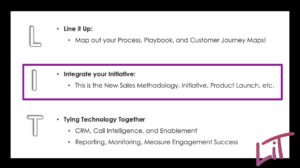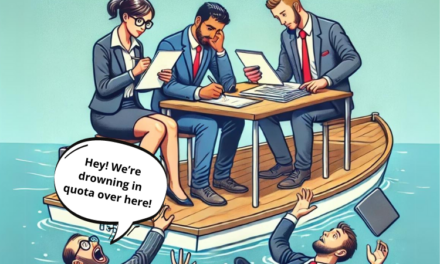
Don’t Let Your Initiative Burn-Up; Let’s get LIT!

Delivering Sales Training in 2025?
Are you and your team launching new initiatives? Did you just introduce some new sales training at your SKO? Get ready to burn through all that money—and the budget you worked so hard to secure—because the sales team will forget 80% of the information within 90 days (Cespedes & Lee, 2017).
Companies Spend 70 Billion on Sales Training
“U.S. companies spend over $70 billion annually on training and an average of $1,459 per salesperson — almost 20 percent more than they spend on workers in all other functions. Yet, when it comes to equipping sales teams with relevant knowledge and skills, the ROI of sales training is disappointing. Studies indicate participants in traditional curriculum-based training forget more than 80 percent of the information they were taught within 90 days” (Cespedes & Lee, 2017, para 1).
Maximizing investments in initiatives like sales training is crucial for any organization’s success—whether in Sales, Marketing, Customer Success, Revenue Operations, Sales Enablement, Product, or any other department. Making an initiative stick can mean the difference between being wildly successful or falling short. The proper execution of new initiatives determines success or failure and centers on coordination, communication, and enablement. GTM teams must focus on connecting the dots between methodology, process, and systems. Fully connecting these elements enables teams to be agile, retain knowledge, and achieve results. This approach not only aids in cost justification but also significantly impacts outcomes.
Problem to Solve
In the business world, a common issue arises: organizations struggle to implement programs from end to end and ensure sustainability. Why does this happen? Hermann Ebbinghaus’s “forgetting curve” is real. Sales training delivered at events such as SKOs or RKOs is 90% forgotten within 30 days without intervention (Breed & Moore, 2022). Spaced learning is essential to counteract the forgetting curve, which is where RevOps and Enablement play a crucial role.
Additional challenges that hinder cohesion within organizations include siloed departments, disjointed objectives, and a lack of communication. We’ve all experienced the challenges and successes of rolling out initiatives—I know I have led both unsuccessful and wildly successful ones. The successful ones always share key ingredients.
When it comes to Revenue Operations and Enablement functions, every organization seems to approach them differently. Even if the “titles” don’t exist in the organization, the responsibilities belong somewhere. What I’ve learned is that reporting structures vary, but the requirements for success remain consistent: they involve both Revenue Operations and Revenue Enablement (or equivalent roles) and many other stakeholders across the company.
Whether launching a new sales methodology, implementing system changes, or introducing new product initiatives, one thing is clear: coordination is key. By “coordination,” I mean true cross-departmental collaboration. Any new tool, strategy, or product launch must be tied to metrics and include shared objectives across teams. Regardless of whether Enablement falls under the Revenue Org, HR Org, or RevOps Org, achieving complete alignment between internal and external stakeholders is what truly matters.
Let’s Get LIT!
Figure 1.
LIT Framework

Note: From Sandy Robinson, M.Ed. (2025) presentation “Let’s Get LIT” at the Revenue Revolt on January 22, 2025.
Line It Up
Map out your process, playbook, and customer journey maps. Define the steps, timing, and key participants. Update playbooks and customer journey maps to reflect these changes. Align the team, plan for continuous learning, and establish a cohesive approach. This coordinated effort should be led by RevOps and must include all stakeholders in the organization.
Without this step, it will be difficult for the team to know what to do to successfully execute the initiative. Imagine a sales rep looking for the next step in the playbook but not knowing what or when to act. It’s critical to map out how the initiative layers into current processes so the team can follow through effectively—rather than making it up as they go, which leads to the dreaded “flavor of the week” syndrome.
Integrate the Initiative
The initiative could be a new sales methodology, program, incentive, product launch, or something else entirely. Whatever it is, it must be at the center of the organization’s efforts. For example, if it’s a sales methodology, ensure it is integrated across departments, involves key stakeholders, and is embedded throughout the organization.
Tying Technology Together
Without the right tools, you may as well quit before you start! The critical tools are your CRM, call intelligence tools such as Gong, Zoom Revenue Accelerator, and Ebsta, as well as Enablement tools like GTM Buddy, Seismic, or Docket AI. Even organized Google Drives can make a difference!
Technology alignment not only enables ease of access for users but also provides valuable insights for all teams. A study by Allego found that 76% of companies identify poor adoption of sales tools as a primary reason their teams miss quotas (Hall, n.d.). Additionally, 86% of sales representatives become confused about which tool to use for specific tasks, leading to inefficiencies and missed quotas (Hall, n.d.).
To measure the success of any initiative, the technology must be operating effectively and fully adopted by the teams. If the tools aren’t set up correctly, how can you understand whether the program is effective? Revenue technology (RevTech) is critical to any initiative’s success. After rollout, focus on continuous improvement and iterations. Ensure the initiative is reflected in the tools and processes that empower the team’s success, making it evident at every touchpoint.
Common Pain Points
Every organization is unique, but a common pain point is a lack of alignment from the C-suite across departments. I’ve heard comments like, “That’s a sales initiative,” but last I checked, if sales fail, every other department is impacted. For example, if a company is rolling out GAP Selling, it’s a company initiative—everyone should at least be aware, regardless of role. It’s not “just for sales.”
Here are a few questions to consider:
- Is your organization ready?
- Do you have top-down alignment?
- Do you have cross-functional support?
- Have you planned internal communication and enablement?
- Have you defined the “why” for rolling out the initiative?
Communication is the key to breaking down silos, and this is where Enablement and RevOps must work together. With over 20 years of experience in Sales, Marketing, RevOps, Training, and Enablement, I’ve witnessed these dynamics firsthand. Alignment in training, communication, and coaching is critical to the success of any initiative.
Final Thoughts
Having held roles in RevOps for the last decade, I can attest to the importance of establishing Enablement as a core part of every program. Without effective Enablement, any RevOps-led initiative is at risk of failure. The solution lies in creating a solid playbook that includes a communication strategy, a robust support structure, and continuous evaluation. Considering the L.I.T. framework when planning initiatives will increase your ability to execute a successful program.
References:
Breed, Michael D., & Moore, Janice. (2022). Forgetting Curve. Animal Behavior (Third Edition). Retrieved January 26, 2025 from: https://www.sciencedirect.com/topics/agricultural-and-biological-sciences/forgetting-curve
Cespedes, Frank V. & Lee, Yuchun. ( 2017, June 12).Your Sales Training Is Probably Lackluster. Here’s How to Fix It. HBR.org. https://hbr.org/2017/06/your-sales-training-is-probably-lackluster-heres-how-to-fix-it
Hall, Gina, (n.d.). New Allego Research: Poor Adoption of Sales Tools Causes Reps to Miss Quotas. Allego. https://www.allego.com/blog/new-research-poor-adoption-of-sales-tools-causes-missed-quotas
































